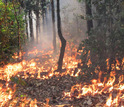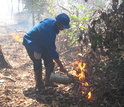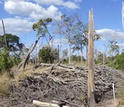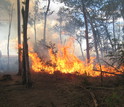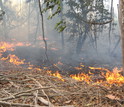News Release 14-053
Drought and fire in the Amazon lead to sharp increases in forest tree mortality
Deforestation and fragmentation of forests help create tinderbox conditions
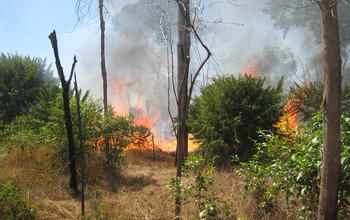
Grasses in Mato Grosso, Brazil, catch fire regularly near the edges of forests and croplands.
April 14, 2014
This material is available primarily for archival purposes. Telephone numbers or other contact information may be out of date; please see current contact information at media contacts.
Ongoing deforestation and fragmentation of forests in the Amazon help create tinderbox conditions for wildfires, contributing to rapid and widespread forest loss during drought years, according to a team of researchers.
Their findings show that forests in the Amazon could reach a "tipping point" when severe droughts coupled with forest fires lead to large-scale loss of trees, making recovery more difficult, said Jennifer Balch, a geographer at Penn State University.
"We documented one of the highest tree mortality rates witnessed in Amazon forests," Balch said. "Over the course of our experiment, 60 percent of the trees died with combined drought and repeated fire.
"Our results suggest that a perfect firestorm, caused by drought conditions and previous fire disturbance, crossed a threshold in forest resistance."
The researchers conclude in today's issue of the journal Proceedings of the National Academy of Sciences (PNAS) that "efforts to end deforestation in the Amazon must be accompanied by programs and policies that reduce the accidental spread of land management fires into neighboring forests--and effectively control forest fires when started."
Balch noted that climate change is expected to warm the air in the Amazon region by several degrees and substantially reduce regional precipitation, making understanding the interactions between droughts and fires even more important.
"However, before any prediction of Amazon climate warming occurs, our study demonstrates that drought and fire are already driving forest dieback," she said.
The eight-year study is the largest and longest-running fire experiment in tropical forests. The researchers burned 50-hectare forest plots in the Southeastern Amazon, a region prone to the effects of climate change.
"If drought and wildfires happen in the same time-frame, there are far-reaching consequences for the health of Amazon forests," said Henry Gholz, a program director in the National Science Foundation Division of Environmental Biology, which funded the research. "When climate change becomes part of the mix, questions for these forests loom yet larger."
The plots were burned every year, every three years, or not at all. The timeframe for the study included 2007, a year of severe drought.
By comparing the tree deaths for the plots each year, the researchers could assess the effect of drought on fire intensity and tree deaths.
"Drought causes more intense and widespread fires," said lead PNAS paper author Paulo Brando of the Instituto de Pesquisa Ambiental da Amazônia, Carnegie Institution for Science, and Woods Hole Research Center.
"Four times more adult trees were killed by fire during a drought year, which means that there was also more carbon dioxide released to the atmosphere, more tree species loss and a greater likelihood of grasses invading the forest."
The researchers found that fragmented forests are more susceptible to the effects of drought and fire, and that drought leads to an increase in fuel such as leaves and branches.
The findings are key, in part, because most climate change models have not included the effects of fires on Amazon forests.
"Basically, none of the models used to evaluate future Amazon forest health includes fire, so most of these predictions underestimate the amount of tree death and overestimate overall forest health," said Michael Coe, a scientist at the Woods Hole Research Center.
Fire as a forest management tool can contribute to an increase in severe fires because the resulting thinner canopy leads to drier forest conditions.
This lack of humidity does not dampen fires but does encourage airflow between fields and forests. Fragmented forests also have more edge space, which is susceptible to both fire and invasive grasses, another potential fuel.
"These forests are tough and can take a lot, but if drought reaches a certain level, big trees begin to die," said Daniel Nepstad of the Earth Innovation Institute, who also co-led the project. "We now know that severe drought makes fires more intense, creating a second tree mortality threshold."
The results are important because large portions of the Amazon forest already experience droughts and are susceptible to fire--they are broken into smaller blocks by agriculture and are close to human settlements, the predominant source of fire in the Amazon.
The researchers analyzed NASA satellite data to provide regional context for results from the experimental burns.
"In 2007, fires in Southeast Amazonia burned 10 times more forest than in an average climate year -- an area equivalent to a million soccer fields," said scientist Douglas Morton of NASA.
"These smaller forest fragments have more edges than large blocks of forest, which expose them to the hotter, drier conditions in the surrounding landscape and make them more vulnerable to escaped fires," said researcher Marcia Macedo of the Woods Hole Research Center.
By 2011, about eight percent of Southeast Amazonia's forests were less than 328 feet from an agricultural or pasture clearing. This lattice-like network of degraded forest edges is now very susceptible to future fires.
The research was also funded by the Packard Foundation, NASA and the Max Planck Institute for Biogeochemistry.
-NSF-
-
Experimental fire burning the understory of a forest between Cerrado and Amazonia, Brazil.
Credit and Larger Version -
Advancing fire line in an experimental fire plot in Mato Grosso, Brazil.
Credit and Larger Version -
Forest degraded by experimental fires in Mato Grosso, Brazil.
Credit and Larger Version -
Igniting an experimental fire in the Brazilian forest, using a drip torch.
Credit and Larger Version -
Fire experiment in Mato Grasso, Brazil; tinderbox grasses lie along forests and croplands.
Credit and Larger Version
Media Contacts
Cheryl Dybas, NSF, (703) 292-7734, email: cdybas@nsf.gov
Eunice Yeomans, WHRC, (508) 444-1509, email: eyoumans@whrc.org
Anne Danahy, PSU, (814) 865-4504, email: acd2@psu.edu
The U.S. National Science Foundation propels the nation forward by advancing fundamental research in all fields of science and engineering. NSF supports research and people by providing facilities, instruments and funding to support their ingenuity and sustain the U.S. as a global leader in research and innovation. With a fiscal year 2023 budget of $9.5 billion, NSF funds reach all 50 states through grants to nearly 2,000 colleges, universities and institutions. Each year, NSF receives more than 40,000 competitive proposals and makes about 11,000 new awards. Those awards include support for cooperative research with industry, Arctic and Antarctic research and operations, and U.S. participation in international scientific efforts.
Connect with us online
NSF website: nsf.gov
NSF News: nsf.gov/news
For News Media: nsf.gov/news/newsroom
Statistics: nsf.gov/statistics/
Awards database: nsf.gov/awardsearch/
Follow us on social
Twitter: twitter.com/NSF
Facebook: facebook.com/US.NSF
Instagram: instagram.com/nsfgov



